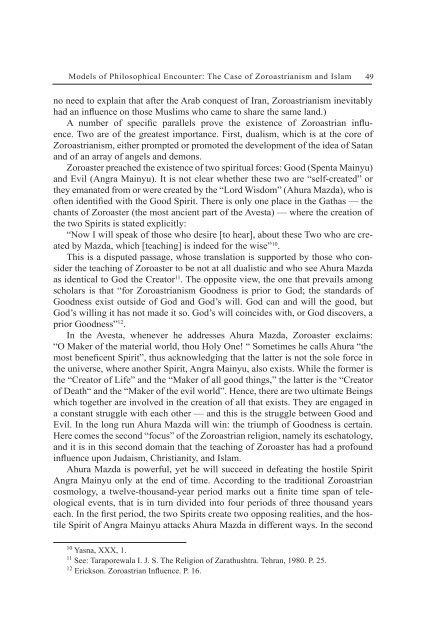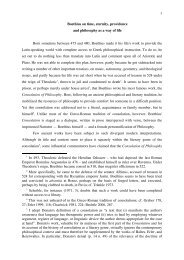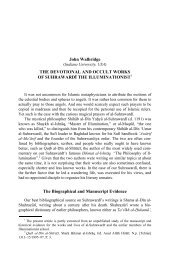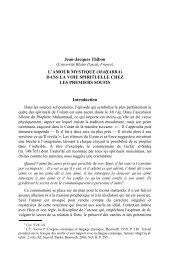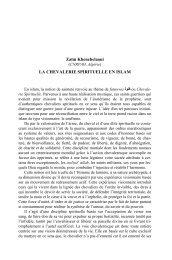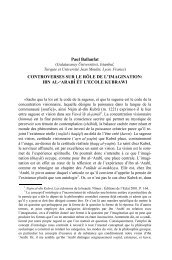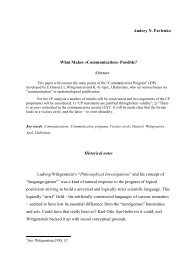Marietta Stepanyants (Institute of Philosophy, Russian Academy of ...
Marietta Stepanyants (Institute of Philosophy, Russian Academy of ...
Marietta Stepanyants (Institute of Philosophy, Russian Academy of ...
Create successful ePaper yourself
Turn your PDF publications into a flip-book with our unique Google optimized e-Paper software.
Models <strong>of</strong> Philosophical Encounter: The Case <strong>of</strong> Zoroastrianism and Islam 49<br />
no need to explain that after the Arab conquest <strong>of</strong> Iran, Zoroastrianism inevitably<br />
had an influence on those Muslims who came to share the same land.)<br />
A number <strong>of</strong> specific parallels prove the existence <strong>of</strong> Zoroastrian influence.<br />
Two are <strong>of</strong> the greatest importance. First, dualism, which is at the core <strong>of</strong><br />
Zoroastrianism, either prompted or promoted the development <strong>of</strong> the idea <strong>of</strong> Satan<br />
and <strong>of</strong> an array <strong>of</strong> angels and demons.<br />
Zoroaster preached the existence <strong>of</strong> two spiritual forces: Good (Spenta Mainyu)<br />
and Evil (Angra Mainyu). It is not clear whether these two are “self-created” or<br />
they emanated from or were created by the “Lord Wisdom” (Ahura Mazda), who is<br />
<strong>of</strong>ten identified with the Good Spirit. There is only one place in the Gathas — the<br />
chants <strong>of</strong> Zoroaster (the most ancient part <strong>of</strong> the Avesta) — where the creation <strong>of</strong><br />
the two Spirits is stated explicitly:<br />
“Now I will speak <strong>of</strong> those who desire [to hear], about these Two who are created<br />
by Mazda, which [teaching] is indeed for the wise” 10 .<br />
This is a disputed passage, whose translation is supported by those who consider<br />
the teaching <strong>of</strong> Zoroaster to be not at all dualistic and who see Ahura Mazda<br />
as identical to God the Creator 11 . The opposite view, the one that prevails among<br />
scholars is that “for Zoroastrianism Goodness is prior to God; the standards <strong>of</strong><br />
Goodness exist outside <strong>of</strong> God and God’s will. God can and will the good, but<br />
God’s willing it has not made it so. God’s will coincides with, or God discovers, a<br />
prior Goodness” 12 .<br />
In the Avesta, whenever he addresses Ahura Mazda, Zoroaster exclaims:<br />
“O Maker <strong>of</strong> the material world, thou Holy One! “ Sometimes he calls Ahura “the<br />
most beneficent Spirit”, thus acknowledging that the latter is not the sole force in<br />
the universe, where another Spirit, Angra Mainyu, also exists. While the former is<br />
the “Creator <strong>of</strong> Life” and the “Maker <strong>of</strong> all good things,” the latter is the “Creator<br />
<strong>of</strong> Death“ and the “Maker <strong>of</strong> the evil world”. Hence, there are two ultimate Beings<br />
which together are involved in the creation <strong>of</strong> all that exists. They are engaged in<br />
a constant struggle with each other — and this is the struggle between Good and<br />
Evil. In the long run Ahura Mazda will win: the triumph <strong>of</strong> Goodness is certain.<br />
Here comes the second “focus” <strong>of</strong> the Zoroastrian religion, namely its eschatology,<br />
and it is in this second domain that the teaching <strong>of</strong> Zoroaster has had a pr<strong>of</strong>ound<br />
influence upon Judaism, Christianity, and Islam.<br />
Ahura Mazda is powerful, yet he will succeed in defeating the hostile Spirit<br />
Angra Mainyu only at the end <strong>of</strong> time. According to the traditional Zoroastrian<br />
cosmology, a twelve-thousand-year period marks out a finite time span <strong>of</strong> teleological<br />
events, that is in turn divided into four periods <strong>of</strong> three thousand years<br />
each. In the first period, the two Spirits create two opposing realities, and the hostile<br />
Spirit <strong>of</strong> Angra Mainyu attacks Ahura Mazda in different ways. In the second<br />
10 Yasna, XXX, 1.<br />
11 See: Taraporewala I. J. S. The Religion <strong>of</strong> Zarathushtra. Tehran, 1980. P. 25.<br />
12 Erickson. Zoroastrian Influence. P. 16.


